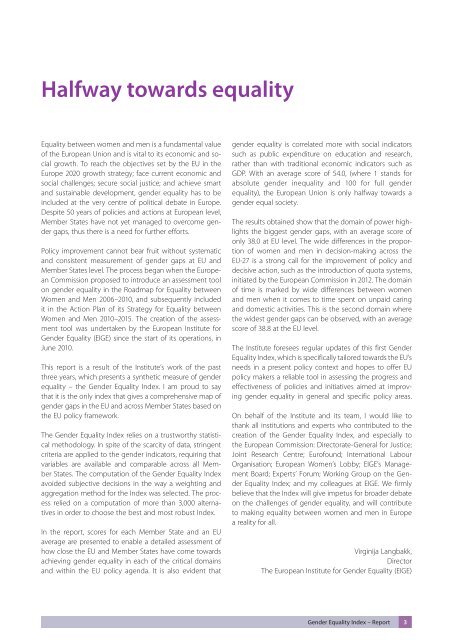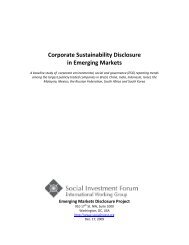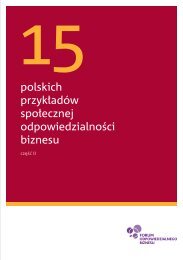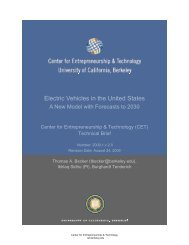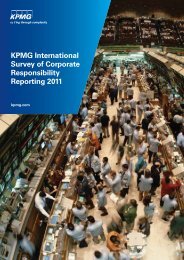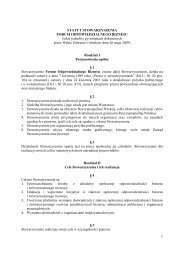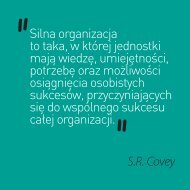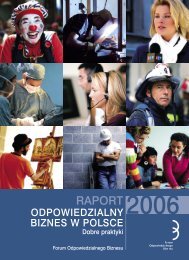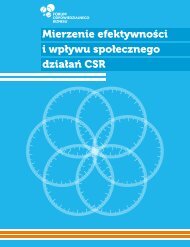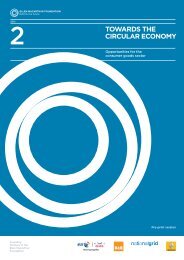Gender Equality Index Report - European Institute for Gender ...
Gender Equality Index Report - European Institute for Gender ...
Gender Equality Index Report - European Institute for Gender ...
You also want an ePaper? Increase the reach of your titles
YUMPU automatically turns print PDFs into web optimized ePapers that Google loves.
Halfway towards equality<br />
<strong>Equality</strong> between women and men is a fundamental value<br />
of the <strong>European</strong> Union and is vital to its economic and social<br />
growth. To reach the objectives set by the EU in the<br />
Europe 2020 growth strategy; face current economic and<br />
social challenges; secure social justice; and achieve smart<br />
and sustainable development, gender equality has to be<br />
included at the very centre of political debate in Europe.<br />
Despite 50 years of policies and actions at <strong>European</strong> level,<br />
Member States have not yet managed to overcome gender<br />
gaps, thus there is a need <strong>for</strong> further ef<strong>for</strong>ts.<br />
Policy improvement cannot bear fruit without systematic<br />
and consistent measurement of gender gaps at EU and<br />
Member States level. The process began when the <strong>European</strong><br />
Commission proposed to introduce an assessment tool<br />
on gender equality in the Roadmap <strong>for</strong> <strong>Equality</strong> between<br />
Women and Men 2006–2010, and subsequently included<br />
it in the Action Plan of its Strategy <strong>for</strong> <strong>Equality</strong> between<br />
Women and Men 2010–2015. The creation of the assessment<br />
tool was undertaken by the <strong>European</strong> <strong>Institute</strong> <strong>for</strong><br />
<strong>Gender</strong> <strong>Equality</strong> (EIGE) since the start of its operations, in<br />
June 2010.<br />
This report is a result of the <strong>Institute</strong>’s work of the past<br />
three years, which presents a synthetic measure of gender<br />
equality – the <strong>Gender</strong> <strong>Equality</strong> <strong>Index</strong>. I am proud to say<br />
that it is the only index that gives a comprehensive map of<br />
gender gaps in the EU and across Member States based on<br />
the EU policy framework.<br />
The <strong>Gender</strong> <strong>Equality</strong> <strong>Index</strong> relies on a trustworthy statistical<br />
methodology. In spite of the scarcity of data, stringent<br />
criteria are applied to the gender indicators, requiring that<br />
variables are available and comparable across all Member<br />
States. The computation of the <strong>Gender</strong> <strong>Equality</strong> <strong>Index</strong><br />
avoided subjective decisions in the way a weighting and<br />
aggregation method <strong>for</strong> the <strong>Index</strong> was selected. The process<br />
relied on a computation of more than 3,000 alternatives<br />
in order to choose the best and most robust <strong>Index</strong>.<br />
In the report, scores <strong>for</strong> each Member State and an EU<br />
average are presented to enable a detailed assessment of<br />
how close the EU and Member States have come towards<br />
achieving gender equality in each of the critical domains<br />
and within the EU policy agenda. It is also evident that<br />
gender equality is correlated more with social indicators<br />
such as public expenditure on education and research,<br />
rather than with traditional economic indicators such as<br />
GDP. With an average score of 54.0, (where 1 stands <strong>for</strong><br />
absolute gender inequality and 100 <strong>for</strong> full gender<br />
equality), the <strong>European</strong> Union is only halfway towards a<br />
gender equal society.<br />
The results obtained show that the domain of power highlights<br />
the biggest gender gaps, with an average score of<br />
only 38.0 at EU level. The wide differences in the proportion<br />
of women and men in decision-making across the<br />
EU-27 is a strong call <strong>for</strong> the improvement of policy and<br />
decisive action, such as the introduction of quota systems,<br />
initiated by the <strong>European</strong> Commission in 2012. The domain<br />
of time is marked by wide differences between women<br />
and men when it comes to time spent on unpaid caring<br />
and domestic activities. This is the second domain where<br />
the widest gender gaps can be observed, with an average<br />
score of 38.8 at the EU level.<br />
The <strong>Institute</strong> <strong>for</strong>esees regular updates of this first <strong>Gender</strong><br />
<strong>Equality</strong> <strong>Index</strong>, which is specifically tailored towards the EU’s<br />
needs in a present policy context and hopes to offer EU<br />
policy makers a reliable tool in assessing the progress and<br />
effectiveness of policies and initiatives aimed at improving<br />
gender equality in general and specific policy areas.<br />
On behalf of the <strong>Institute</strong> and its team, I would like to<br />
thank all institutions and experts who contributed to the<br />
creation of the <strong>Gender</strong> <strong>Equality</strong> <strong>Index</strong>, and especially to<br />
the <strong>European</strong> Commission: Directorate-General <strong>for</strong> Justice;<br />
Joint Research Centre; Eurofound; International Labour<br />
Organisation; <strong>European</strong> Women’s Lobby; EIGE’s Management<br />
Board; Experts’ Forum; Working Group on the <strong>Gender</strong><br />
<strong>Equality</strong> <strong>Index</strong>; and my colleagues at EIGE. We firmly<br />
believe that the <strong>Index</strong> will give impetus <strong>for</strong> broader debate<br />
on the challenges of gender equality, and will contribute<br />
to making equality between women and men in Europe<br />
a reality <strong>for</strong> all.<br />
Virginija Langbakk,<br />
Director<br />
The <strong>European</strong> <strong>Institute</strong> <strong>for</strong> <strong>Gender</strong> <strong>Equality</strong> (EIGE)<br />
<strong>Gender</strong> <strong>Equality</strong> <strong>Index</strong> – <strong>Report</strong><br />
3


